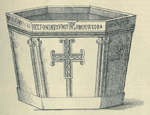|
Gregory of Nin
Gregory of Nin (Croatian: Grgur Ninski pronounced [ɡr̩̂ɡuːr nîːnskiː]; Latin: Gregorius Ninnius) was a Croatian Catholic prelate who served as a medieval Bishop of Nin and strongly opposed the pope and official circles of the Catholic Church.[further explanation needed] He introduced the Croatian language in the religious services after the Great Assembly in 926, according to traditional Croatian historiography. Until that time, services were held only in Latin (being under the jurisdiction of Roman influence before the Great Schism), not being understandable to a majority of the population. Not only was this important for Croatian language and culture, but it also made Christianity stronger within the Croatian kingdom.[1][page needed] Historical factsGregory was the Bishop of Nin and as such was under the strong protection of King Tomislav of Croatia. At the Synod in 925, held in Split, Gregory became subordinate to the Archbishop of Split.[2] He rejected the offer of the Sisak Bishopric. After the conclusions of the first Synod Gregory complained again in 927/8 but was rejected and his Nin bishopric was abolished, Gregory himself being transferred to the Diocese of Skradin.[3] The statueThe 8.5-metre (28 ft)[4] tall statue of Gregory of Nin by Ivan Meštrović in Split is a busy tourist site in the town, which the toe of the statue shows. Rubbing the statue's toe is said to bring good luck.[1][page needed][5] The toe has been worn smooth and shiny as a result. The statue was erected in September 1929 in the Peristyle of Diocletian's Palace and can be seen in postcards of the pre-World War II period. In 1941, the statue was moved outside the city by Italian occupying forces. In 1954, it was re-erected in a different location, to the north of the Palace and Old Town of Split, just outside the Golden Gate and near the park Djardin (Croatian: Đardin), where it currently sits. A major restoration of the monument took place between 2013 and 2015.[6] There are also statues of Gregory of Nin in the cities of Nin and Varaždin.[5] See alsoReferences
Further reading
Wikimedia Commons has media related to Grgur Ninski. |
|||||||||||||||||||||||||||||||||||||

